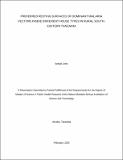| dc.description.abstract | Malaria control in Africa relies extensively on indoor residual spraying (IRS) and insecticidetreated
nets
(ITNs).
Indoor
residual
spraying
typically
targets
mosquitoes
resting
on
walls,
and
in
few
cases,
roofs
and
ceilings,
using
contact
insecticides.
Unfortunately,
little
attention
is
paid
to
where
malaria vectors actually rest indoors, and how such knowledge could be used to improve
IRS. This study investigated preferred resting surfaces of two major malaria vectors, Anopheles
funestus and Anopheles arabiensis, inside four common house types in rural south-eastern
Tanzania. The assessment was done inside 80 houses in south-eastern Tanzania across four
villages. In each house, resting mosquitoes were captured using Prokopack aspirators from walls,
undersides of roofs, floors, furniture, utensils, clothes and bed-nets. Overall, only 26% of An.
funestus and 18% of An. arabiensis were found on walls. In grass-thatched houses, 33-55% of An.
funestus and 43-50% of An. arabiensis rested under roofs, while in metal-roofed houses, only 1620%
of
An.
funestus
and
8-30%
of
An.
arabiensis
rested
under
roofs.
Considering
all
data
together,
approximately
40% of mosquitoes rested on surfaces not typically targeted by IRS, i.e. floors,
furniture, utensils, clothes and bed-nets. These proportions were particularly high in metal-roofed
houses (47-53% of An. funestus; 60-66% of An. arabiensis). While IRS uses contact insecticides
to target adult mosquitoes on walls, and occasionally roofs and ceilings, significant proportions of
vectors rest on surfaces not usually sprayed. This gap exceeds one-third of malaria mosquitoes in
grass-thatched houses, and can reach two-thirds in metal-roofed houses. Where field operations
exclude roofs during IRS, the gaps can be much greater. In conclusion, there is need for locallyobtained
data
on
mosquito
resting
behaviours
and
how
these
influence
the
overall
impact
and
costs
of
IRS. | en_US |


